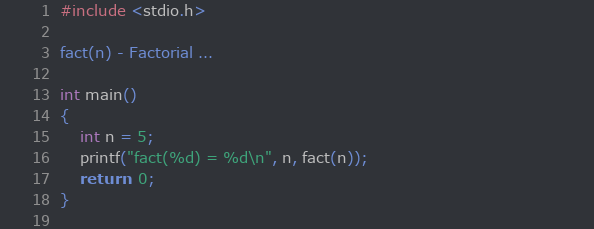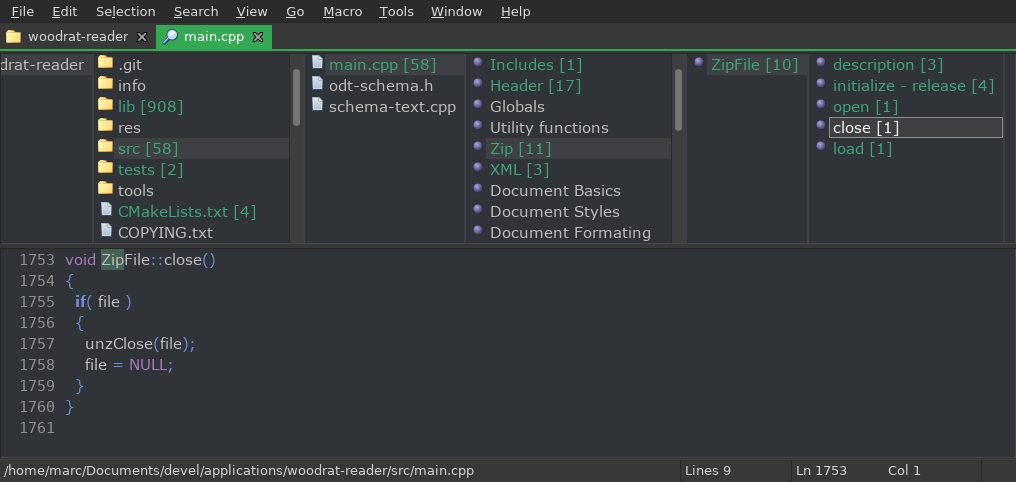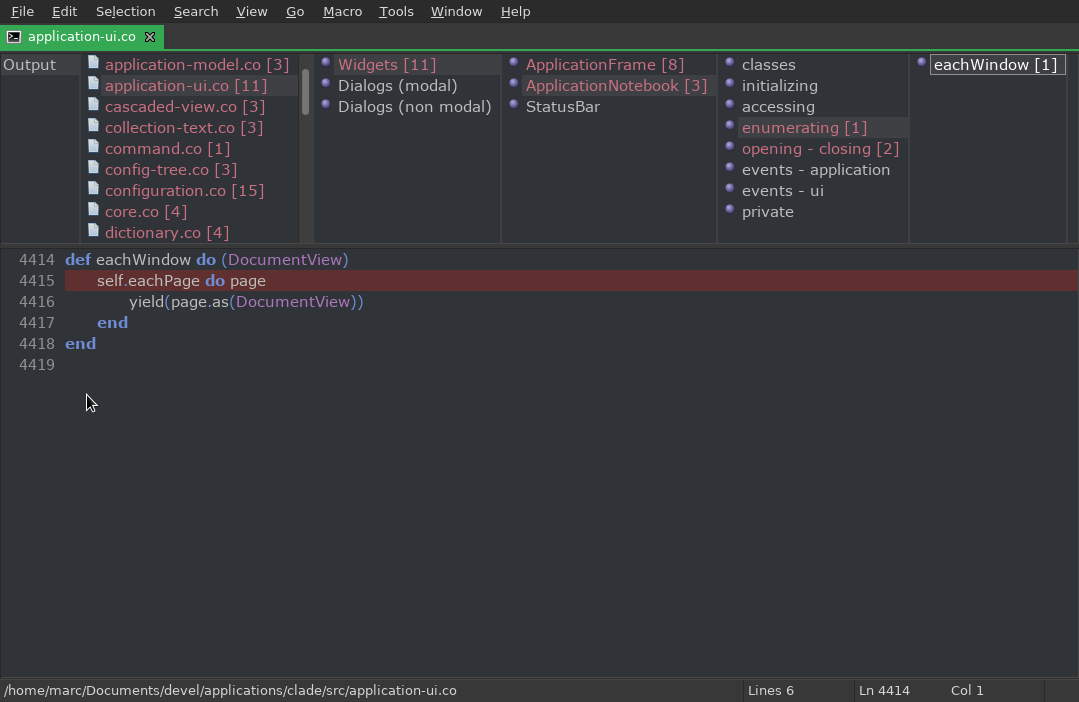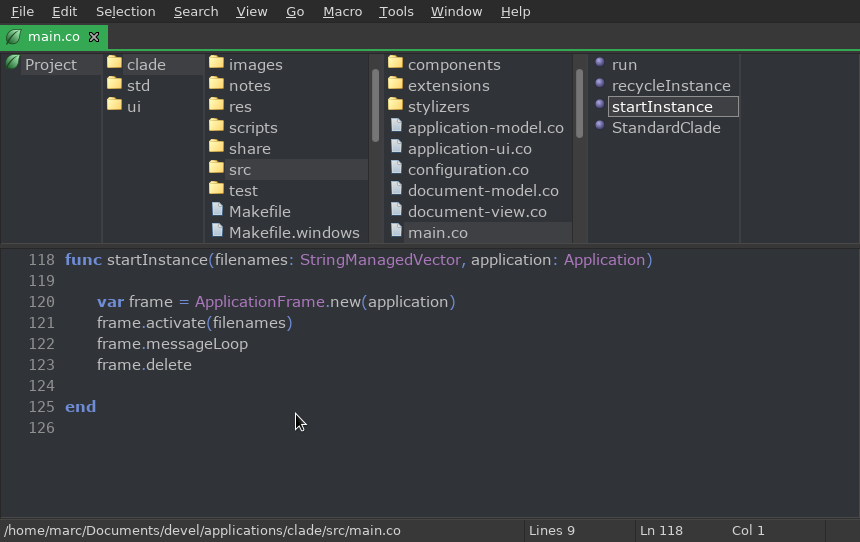Documentation
Table of Content
Introduction
Clade is a text editor with most common features found in programming editors: syntax highlighting, launch external tools, advanced search and replace, brace matching, ...
But Clade implements a unique marker-based folding and navigation system. It allows you to structure your source code like an hyper-text document: the source code can be cut into sections and sub-sections independently of the file structure. It gives a better visibilty on large projects and makes navigation easier.
Folding
Folding allows to hide a group of lines in a text file and to show only a descriptive headline instead. This allows to hide the details and to show the structure of a text file, like the summary of a book.
Clade implements marker-based folding: markers are inserted in the text file to delimit the beginning and the end of the sections of text to hide. These markers are embedded into program comments to prevent a compiler to interpret them, so it does not require any transformation before compilation. Plain text files can be folded as well as source code: the editor uses the '#' character as comment.
This method is the most flexible, you can fold any group of lines and specify any descriptive headline but it requires more work as you have to select manually the regions of text to be folded and provide a headline for each one.
Example
This is a small example in C, the fact function is folded with just a headline displayed. The implementation detail of the function is hidden an there is only a descriptive headline visible.

There are markers in comments at the beginning and at the end of the function, for the compiler, it is a perfectly valid source code. [of] stands for 'Open Fold' marker: it marks the beginning of the section. [cf] stands for 'Close Fold' marker: it marks the end of the section.
#include <stdio.h>
//[of]:fact(n) - Factorial
int fact(int n)
{
if( n < 2 )
return 1;
else
return n * fact(n-1);
}
//[cf]
int main()
{
int n = 5;
printf("fact(%d) = %d\n", n, fact(n));
return 0;
}
Clade does not collapse and expand folded sections as in most folding editors. Instead, it always shows a folded section alone.
Sections can be nested, so a text file is no longer flat but becomes a hierarchy of sections. There are several way to navigate through such a hierarchy.
User Inteface
Files and Windows
Files and Windows are independent:
- A window can edit multiple files.
- A file can be edited in multiple windows.
Opening a File
The Open command from the File menu opens a file in a new window. If this file is already loaded, it is not reloaded.
Viewing Loaded Files
The Files command from the File menu shows all loaded files and allows to open or re-open a file in a new window.
Closing a Window
Use the Close command from the Window menu to close the active window. This command unloads a file only if it is not used in another window.
If you close a window with a modified file, you will be asked to save changes but in some case it does not happen. Don't panic. The file is referenced somewhere else (in a search result, from another window...). Just use the File manager to reopen the file. You'll will be asked to save it anyway when exiting.
Cloning a Window
Use the Clone command from the Window menu to create an exact copy of the active window: the new window will have the same layouts that display the same sections in panes.
Reloading a File
A file can be reloaded when it is modified by another application. The reload-mode in options can change the behavior when an external file change is detected:
never: never reloadask: ask before reloadalways: reload without asking unless the file is modified
Splitting the Main Window
By default the application shows tabs in a single notebook, but it is possible to split the main window in two side-by-side notebooks. Use Move Window to Other Notebook from the Window menu.

Documents
A window does not edit a file directly, instead, it edits a Document. A document is basically a hierarchy of folders, file and sections of text. The application distinguishes several kind of documents:
- A single file document
- A folder document
- A project document
- An option document
- A search result document
- An output document
A specific icon in the tab shows the kind of the document:
 File
File Folder
Folder Project
Project Options
Options Search Result
Search Result Output
Output
File Document
When opening or creating a file, a file document is opened: it just contains the file at the root.
Folder Document
When opening a folder from the menu or when dropping a folder into the editor, a folder document is opened: the root is the folder.
Project Document
A project document is similar to a folder document, but it can have additional files and folders attached to it and have custom user tools. The editor can have only one project document opened (but a document can be opened on multiple windows).
Option Document
This document is a special document that give an access to all loaded option files:
global-options.cbcThe global options. This one should not be modifieduser-options.cbcThe user options, it can override global options.project.cbcThe project options, available if a project is open.- Any additional file imported from another option file.
Search Result Document
This is a special document that allows navigation through the result of the current search. All folders, files and sections that were part of the search are shown, the ones containing one or more matches are highlighted and show the number of occurrences found at this level.

Output Document
This document is generated after running a User Tool: it usually collects errors and warnings that reference a line in a file.

Navigator
The navigator is the display of cascading lists at the top of windows.

It can be shown or hidden from the View menu, or using the CTRL+Return shortcut.
The navigator provides convenient shortcuts to navigate through a document, this applies when the focus is on the navigator:
| Shortcut | Command |
|---|---|
| Up | Previous line. If first line, it can go to the last line of the previous parent. |
| Down | Next line. If last line, it can go to the first line of the next parent. |
| Left | Previous list |
| Right | Next list |
| Home | First line |
| End | Last line |
| Page Up | Previous page |
| Page Down | Next page |
| CTRL+Home | First list |
| CTRL+End | Last list |
| Any letter | Access to the next line starting with this letter |
When opening a new window on a document, the navigator will be visible by default depending on the kind of document and some properties:
- File document: determined by the
layoutoption of the associated language.
For search results and output, the navigator will be always visible by default.
Editing
Undoing a Change
There is an unlimited undo stack for each loaded file. Undo and Redo commands applies to the current file.
Copying and Pasting
Copying text from Clade will preserve the sections.
When pasting into another application, it will become a flat text, sections will just be expanded with a comment as the title of sections.
It is possible to copy a text into Clade without the folded sections as when copying to another application using Paste as Raw Text from the Edit menu.
Inserting a New Section
To insert a new section into a text file, use the Insert Section command from the Edit menu or press F12. If there is some text selected, is will be moved to the content of the section and the first line will be used as a default headline.
Inserting a Comment Line
Comment lines are just comments. They are displayed with an alternate background and without delimiter. It's only to prettify the code or make it a bit more like literate programming.
To insert a new comment, use the Insert Comment Line command from the Edit menu or press CTRL+SHIFT+C. If there is some text selected, is will be transformed into comment. Use the Insert Text Line command to revert the operation.
Searching
Clade has two types of search and replace: iterative and global. The global one searches all occurrences of a string and displays a list of matching lines.
Regular expressions can be used to search and replace complex expressions.
Special Characters in Search Pattern
| Expression | Description |
|---|---|
| . | Matches any single character except newline |
| ^ | Matches the beginning of line if it is the first character of the search pattern |
| $ | Matches the end of line if it is the last character of the search pattern |
| ? | Matches the preceding character or group zero or one time |
| * | Matches the preceding character or group zero or more times |
| + | Matches the preceding character or group one or more times |
| ( ) | Group. Used to reuse the matched expression in the replace pattern or to repeat a pattern using ?, * or + |
| [ ] | Matches a set of characters. The expression between bracket is a list of characters and range of character. A range of character is defined using the '-'. Example: [a-zA-Z_] matches any alphabetic character and the underscore. If the first character in the list is a '^', the expression matches all characters except the set of characters. |
| \t | Matches the tab character |
| \ | Matches the character following the backslash: the next character will not be considered as a special character. Useful to match ., ^, $, ?, *, +, [, ], (, ) or \. |
Special Characters in Replace Pattern
| Expression | Description |
|---|---|
| \\ | Inserts a backslash. |
| \1-9 | Inserts the corresponding group. |
Customizing
Lot of stuff can be customized in Clade:
- Create or modify themes.
- Create or modify languages (syntax highlighting, tab behavior, ... for each file type).
- Create tools to launch external programs.
To access option files, use the Options command from the View menu.

Files
There are 3 main option files:
global-options.cbc-- The global optionsuser-options.cbc-- The user options.project.cbc-- The project options
There can be additional option files when imported from one of the files above using the use keyword.
Global Options
The global option file is installed with the program and should not be modified. Instead modify properties in user-options.cbc, it can override anything from the global options anyway.
User Options
The user option file is automatically created in the user's directory:
~/.config/clade-1/user-config.cbcon Unix systems<user>\Application Data\clade-1\user-config.cbcon Windows
Project Options
The project options exists only if there is a project open. It is found in the folder of the project.
General Syntax
A configuration file is just a sequence of properties and elements.
A property name starts with a letter and can contain letters, digits and dashes (-).
property = value
- Blanks preceding and following the value are ignored.
- % is a special character in values.
- Use %% to get a %.
- Use %_ to get a whitespace (whitespaces at the end of line are removed).
An element is a named object containing properties and other elements.
def name
...
end
The name has the same restrictions as property names.
An element can contain a special property 'prototype' that references another element. If this property is set, this element inherits all properties of the specified target element.
Color properties can use the hexadecimal form #RGB or #RRGGBB or it can use the default keyword to get the appropriate system color.
There is a color editor in the Tool menu that can be used to insert or edit existing colors.
Languages
A language element defines how a text file is highlighted and edited. A language is selected by the extension of the filename or the first line of the content, but it can also be changed from the View > Language menu.
Properties:
| Name | Format | Description |
|---|---|---|
| patterns | The list of extension separated by a ';'. If this attribute is empty, and there is no 'first-line-patterns' attribute, this configuration is used as the default one. | |
| first-line-patterns | The list of matching first lines separated by a ';'. Wildcards '*' are accepted. | |
| encoding | default UTF-8 UTF-16-LE UTF-16-BE |
If specified, the file is loaded with the specified encoding even if the file does not contain a BOM marker. A new file is also saved with this encoding. |
| layout |
single hlist tree |
The layout to use when opening a file of this language. |
| tabulation-size | Size of tabulations. | |
| fixed | true false |
Use fixed font by default. |
| word-wrap | true false |
Turns on the word wrapping. |
| word-wrap-max-width | The maximum width for word wrapping, in glyph units. The width is computed using the font for normal text, either fixed or proportional depending on the fixed property. | |
| show-line-type | true false |
Adds a special symbols in a margin to show sections. |
| elastic-tabstops | true false |
Use elastic tabstops by default. |
| expand-tabulation | true false |
A tabulation is replaced by whitespaces. |
| auto-indentation | true false |
Turns on auto-indentation. |
| stylizer |
batch css generic html makefile monochrome python ruby sh tex |
The stylizer is the function that colorize and style the text. Only the generic stylizer uses all the attributes described below. |
| line-comment | The beginning of a comment line. This attribute is used for folding as well as for colorization. | |
| line-comment-2 | The beginning of an alternative comment line. This attribute is used for colorization only. | |
| open-comment | The beginning of a comment block. This attribute is used for folding as well as for colorization. | |
| close-comment | The end of a comment block | |
| open-comment-2 | The beginning of an alternative comment block | |
| close-comment-2 | The end of an alternative comment block | |
| preprocessor | The preprocessor characters (e.g. '#') | |
| hexa-prefix | The hexadecimal prefix (e.g. '0x') | |
| extra-id-chars | Additional identifier chars that can be used in keywords. By
default the identifier chars are [_A-Za-z0-9].
These additional chars do not apply to the first character of an
identifier. |
|
| string-delimiter | The delimiter character for strings | |
| string-escape-char | The escape character inside strings | |
| multiline-string-delimiter | The delimiter character for multiline strings | |
| regex-escape-char | The escape character inside a regex (e.g. '\' in Ruby) | |
| char-delimiter | The delimiter character for characters (or alternative strings) | |
| char-escape-char | The escape character inside characters | |
| multiline-char-delimiter | The delimiter character for multiline characters (or alternative strings) | |
| char-prefix | The prefix character for chars (e.g. '$' in Smalltalk) | |
| variable-prefix | The prefix character for a variable (e.g. '$' in php). It will highlight this character and the following word with the same color as for words-4 | |
| escape-char | The escape character | |
| ignore-case | true false | 'true' if keywords are not case sensitive |
| user1 | First class of words | |
| user2 | Second class of words | |
| user3 | Third class of words | |
| user4 | Fourth class of words |
User Tools
A user tool is a command in the menu that launches an external program and capture the result. A typical usage is to launch an external compiler or interperter. It is possible to pass special values to the command line such as the filename of the current file or the current line number.
Syntax
Properties
| Name | Format | Description |
|---|---|---|
| caption | This text will be displayed in the Tools menu and in the title of the output window. | |
| command | The full name of the command to execute. Blanks are accepted, no need to use quotes. | |
| arguments | The arguments to pass to the command. This attribute accepts
special variables that will be substituted when launching the command.
The syntax is $(variablename) where 'variablename'
is described below. |
|
| directory | The directory where you want the command to execute. This
attribute accepts the same variables as the arguments
attribute. |
|
| save-all | true false |
If true, all files are saved before launching the command. The command will not be launched if at least one save fails. |
| save-current | true false |
If true, the current file is saved before launching the command. The command will not be launched if the save fails. |
| show-window | true false |
Set this attribute to true for graphical tools, set it to false to the other to prevent the opening of a console. This attribute is unused on Unix platform. |
| language | If this value is set, the tool is available only with files of this language. | |
| hot-key | An optional key to launch quickly the tool. The syntax is:
|
|
| auto-close | true false |
If true, the output window will be closed if the tool terminates without error (i.e. exit code = 0) and does not report any link. |
| edit-arguments | true false |
If true, the you will be prompted for arguments. |
| error-pattern- |
A special regular expression to define a custom error pattern:
if a line from the output matches the pattern, it will be recognized
as an error message, the output line will be converted into a link
and the target line will be marked as an error.
The pattern is a regex with the following rules:
Example: an errors such as c:\myproj\src\main.c(15): Error: 'myvar' undefined will be recognized with the pattern |
Variables in Arguments:
| Name | Description |
|---|---|
| WorkDir | The directory of the current project. |
| FilePath | The full name of the current file |
| FileDir | The directory of the current file |
| FileName | The filename without directory and without extension |
| FileNameExt | The filename with extension but without directory |
| CurText | The current selection or the word under the caret. This value will be empty if the selection contains new lines. |
| CurLine | The current line of the caret. This value is an absolute line number i.e. starting from the beginning of the file, not the section. |
| CurCol | The current column of the caret. This value is an offset, tab characters are not expanded. |
Handling Output
When a tool is run, its output is parsed. If a line is recognized as an error or warning message, it will appear in the output window as a link. By default, the editor recognizes two patterns:
filename :line :message filename (line ):message
but it can be customized with the error-pattern properties.
If the file is not an absolute path, the directory specified in tool is used. If there is no directory specified, the current working directory of the editor is used instead.
Example
def tools
def build-cb
caption = Build Code Browser
command = cmd.exe
arguments = /c build.bat
directory = c:\projects\code-browser
save-all = true
hot-key = F7
end
def run-cb
caption = Run Code Browser
command = cb.exe
directory = c:\projects\code-browser
show-window = true
hot-key = F5
end
end